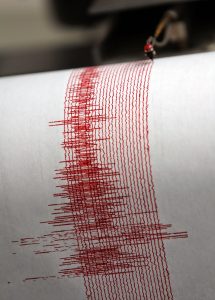
Results of a massive new project to map and classify the earthquake shaking potential across most of the Las Vegas metropolitan area will help developers there build in safer and less expensive ways.
The “Parcel Map” described 28 February in the Bulletin of the Seismological Society of America is the most extensive effort to date in the United States to map and classify soils based on their effects on earthquake shaking across an entire urban area with systematic, direct measurements at high density. These “site classifications” are a key part of the building codes that structural engineers use to design new buildings—or to retrofit older buildings—to withstand earthquake damage.
How much a building might be damaged by an earthquake depends in part on the stiffness (strength) of the ground on which it is built. This stiffness is dependent on the seismic shear-wave velocity of the underlying soil and/or rock. Seismic waves create less shaking when they pass through hard rock which has a high shear-wave velocity, for instance, compared to loose soils which have low shear-wave velocities. The building code bases site classifications on shear-wave velocity that vary with ground conditions.
One of the most important findings of the parcel map study is that much of the ground in the Las Vegas area is actually stiffer (stronger) and potentially safer for building than the current default site classifications for the region indicate.
The default classification used for the Las Vegas metro area is “Class D,” indicating the presence of relatively weak and potentially hazardous soils for building. But the new parcel map suggests that 84% of the mapped region is stiffer than Class D.
Until now, developers in the Las Vegas area had to assume that their building sites were Class D if no other classification had been made. As a result, some developers were requiredto build to more stringent earthquake standards than necessary, potentially increasing the cost of design and construction.
The new Parcel Map could reduce some of these costs, while offering a better way to identify which existing buildings may be prone to shaking in an earthquake. “City officials can then plan retrofit campaigns and ensure buildings meet requisite safety standard on the basis of knowledge, rather than guesswork,” Aasha Pancha and her colleagues write in the BSSA paper.
The parcel map was drawn from more than 10,000 seismic-array measurements taken about every 300 meters, to cover most of urban Las Vegas. This density of measurement was necessary to characterize the natural variability of the observed site class values due to different soils throughout the city. A big factor in developing the map was high demand for building permits and reviews by Clark County, Nevada and the city of Henderson, Nevada, which commissioned the project, said Pancha, now a researcher at Victoria University of Wellington, New Zealand and part of the geotechnical investigation team at Aurecon New Zealand Ltd. Rather than research driven, the project was driven by the practical needs of the planners, developers, builders, and engineers.
“There was an element of serendipity as well,” Pancha added. “Most of the building was going on in an area where measurements were proving the ground to be much stiffer and less hazardous than the defaults allowed in the building code. So there was the prospect of saving money for developers in such areas.”
Property owners, designers, city planners, and developers can now determine the site classification for any particular parcel by consulting the “soil guidelines” map accessible online through the Clark County website.
“What has made Parcel Mapping unique so far to Clark County and the City of Henderson in southern Nevada is that it was an entirely locally-supported project,” Pancha said. “Between the 1970s and today the population of southern Nevada has grown tenfold, and federal allocations for earthquake research and hazard mitigation have in no way kept up with this explosive growth rate.”
“In earthquake-prone areas that are growing rapidly now that the recession has ended, this local commitment to earthquake-hazard mitigation is more likely,” she added.
Reference:
“Large scale earthquake hazard class mapping by parcel in Las Vegas Valley, Nevada,” Bulletin of the Seismological Society of America, 2017.
Note: The above post is reprinted from materials provided by Seismological Society of America.










